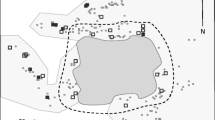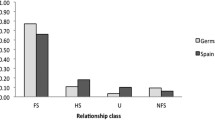Abstract
The causes of variation in rates of extra-pair paternity among avian populations remain unclear, but could include environmental factors such as breeding density and synchrony. By experimentally manipulating nest site availability, we tested the effects of breeding density on the frequency of extra-pair paternity in eastern bluebirds (Sialia sialis). We also examined the role of breeding synchrony on extra-pair paternity using natural timing of nests. Microsatellite analysis revealed 34 of 305 nestlings (11.2%) were the result of extra-pair fertilizations; and 21 of 79 broods (26.6%) had at least one extra-pair nestling. Several measures of breeding density had independent effects on extra-pair paternity. First, experimental plot type affected extra-pair paternity, with 28 of 34 (82.4%) extra-pair young from nests in high density areas, and only six (17.6%) from nests in low density areas. Independently of plot type, the number of breeding neighbors within a 320-m radius was a significant predictor of the likelihood of extra-pair paternity at the nest. Extra-pair paternity was associated with temporal factors such as absolute timing of breeding and natural levels of local breeding synchrony, but only in bivariate comparisons. We found a positive interaction between density of neighbors within a 320-m radius and local breeding synchrony; this term reduced the main effects of synchrony and number of neighbors, but not experimental treatment. Our results demonstrate the importance of utilizing multiple aspects of proximity in breeding density analyses and testing for interactions between ecological factors that can influence the behavioral events leading to extra-pair fertilizations.



Similar content being viewed by others
References
Arlt D, Hansson B, Bensch S, von Schantz T, Hasselquist D (2004) Breeding synchrony does not affect extra-pair paternity in great reed warblers. Behaviour 141:863–880
Balenger SL, Johnson LS, Mays HL Jr, Masters BS (2009) Extra-pair paternity in the socially monogamous mountain bluebird Sialia currucoides and its effect on the potential for sexual selection. J Avian Biol 40:173–180
Bassam BJ, Caetano-Anolles G, Gresshoff PM (1991) Fast and sensitive silver staining of DNA in polyacrylamide gels. Anal Biochem 196:80–83
Beheler AS, Rhodes OE Jr (2003) Within-season prevalence of extrapair young in broods of double-brooded and mate-faithful eastern phoebes (Sayornis phoebe) in Indiana. Auk 120:1054–1061
Birkhead TR (1978) Attendance patterns of guillemots Uria aalge at breeding colonies on Skomer Island. Ibis 120:219–229
Birkhead TR, Biggins JD (1987) Reproductive synchrony and extra-pair copulation in birds. Ethology 74:320–334
Birkhead TR, Moller AP (1992) Sperm competition in birds: evolutionary causes and consequences. Academic, London
Bollinger EK, Gavin TA (1991) Patterns of extra-pair fertilizations in bobolinks. Behav Ecol Sociobiol 29:1–7
Charmantier A, Perret P (2004) Manipulation of nest-box density affects extra-pair paternity in a population of blue tits (Parus caeruleus). Behav Ecol Sociobiol 56:360–365
Chuang HC, Webster MS, Holmes RT (1999) Extrapair paternity and local synchrony in the black-throated blue warbler. Auk 116:726–736
Conrad KF, Robertson RJ, Boag PT (1998) Frequency of extrapair young increases in second broods of eastern phoebes. Auk 115:497–502
Conrad KF, Johnston PV, Crossman C, Kempenaers B, Robertson RJ, Wheelwright NT, Boag PT (2001) High levels of extra-pair paternity in an isolated, low-density, island population of tree swallows (Tachycineta bicolor). Mol Ecol 10:1301–1308
Crawley MJ (2002) Statistical computing: an introduction to data analysis using S-Plus. Wiley and Sons, New York
Dawson DA, Hanotte O, Greig C, Stewart IRK, Burke T (2000) Polymorphic microsatellites in the blue tit Parus caeruleus and their cross-species utility in 20 songbird families. Mol Ecol 9:1941–1944
Dunn PO, Whittingham LA, Lifjeld JT, Robertson RJ, Boag PT (1994) Effects of breeding density, synchrony, and experience on extrapair paternity in tree swallows. Behav Ecol 5:123–129
Gowaty PA, Bridges WC (1991) Nestbox availability affects extra-pair fertilizations and conspecific nest parasitism in eastern bluebirds, Sialia sialis. Anim Behav 41:661–675
Gowaty PA, Plissner JH (1998) Eastern bluebird (Sialia sialis). In: Poole A, Gill F (eds) The Birds of North America, No. 381. The Birds of North America, Inc, Philadelphia, pp 1–31
Gray EM (1997) Female red-winged blackbirds accrue material benefits from copulating with extra-pair males. Anim Behav 53:625–639
Griffith SC, Stewart IRK, Dawson DA, Owens IPF, Burke T (1999) Contrasting levels of extra-pair paternity in mainland and island populations of the house sparrow (Passer domesticus): is there an “island effect”? Biol J Linn Soc 68:303–316
Griffith SC, Owens IPF, Thuman KA (2002) Extra pair paternity in birds: a review of interspecific variation and adaptive function. Mol Ecol 11:2195–2212
Grubb TC Jr (1989) Ptilochronology: feather growth bars as indicators of nutritional status. Auk 106:314–320
Kempenaers B, Verheyen GR, Dhondt AA (1997) Extra-pair paternity in the blue tit (Parus caeruleus): female choice, male characteristics, and offspring quality. Behav Ecol 8:481–492
Kempenaers B, Lanctot RB, Robertson RJ (1998) Certainty of paternity and paternal investment in eastern bluebirds and tree swallows. Anim Behav 55:845–860
Lack D (1968) Ecological adaptations for breeding in birds. Methuen, London
Lubjuhn T, Bruen J, Gerken T, Epplen JT (2001) Inconsistent pattern of extra-pair paternity in first and second broods of the great tit Parus major. Ardea 89:69–73
Major DL, Barber CA (2004) Extra-pair paternity in first and second broods of eastern song sparrows. J Field Ornith 75:152–156
Marshall TC, Slate J, Kruuk LEB et al (1998) Statistical confidence for likelihood-based paternity inference in natural populations. Mol Ecol 7:639–655
Meek SB, Robertson RJ, Boag PT (1994) Extrapair paternity and intraspecific brood parasitism in eastern bluebirds revealed by DNA fingerprinting. Auk 111:739–744
Moller AP (1991) Density-dependent extra-pair copulations in the swallow Hirundo rustica. Ethology 87:316–329
Mulder RA, Dunn PO, Cockburn A, Lazenby-Cohen KA, Howell MJ (1994) Helpers liberate female fairy-wrens from constraints on extra-pair mate choice. Proc R Soc Lond B 255:223–229
Olsen BJ, Greenberg R, Fleischer RC, Walters JR (2008) Extrapair paternity in the swamp sparrow, Melospiza georgiana: male access or female preference? Behav Ecol Sociobiol 63:285–294
Perreault S, Lemon RE, Kuhnlein U (1997) Patterns and correlates of extrapair paternity in American redstarts (Setophaga ruticilla). Behav Ecol 8:612–621
Petrie M, Kempenaers B (1998) Extra-pair paternity in birds: explaining variation between species and populations. Trends Ecol Evol 13:52–58
Piper WH, Evers DC, Meyer MW, Tischler KB, Kaplan JD, Fleischer RC (1997) Genetic monogamy in the common loon (Gavia immer). Behav Ecol Sociobiol 41:25–31
Pitts TD (1985) Identification of second-year and after-second-year eastern bluebirds. J Field Ornithol 56:422–424
Polakova R, Vyskocilova M, Martin JF, Mays HL Jr, Hill GE, Bryja J, Albrecht T (2007) A multiplex set of microsatellite markers for the scarlet rosefinch (Carpodacus erythrinus). Mol Ecol Notes 7:1375–1378
Ratti O, Lundberg A, Tegelstrom H, Alatalo RV (2001) No evidence for effects of breeding density and male removal on extrapair paternity in the pied flycatcher. Auk 118:147–155
Richardson DS, Burke T (2001) Extrapair paternity and variance in reproductive success related to breeding density in Bullock’s orioles. Anim Behav 62:519–527
Rowe KMC, Weatherhead PJ (2007) Social and ecological factors affecting paternity allocation in American robins with overlapping broods. Behav Ecol Sociobiol 61:1283–1291
Rowe DL, Murphy MT, Fleischer RC, Wolf PG (2001) High frequency of extra-pair paternity in eastern kingbirds. Condor 103:845–851
Saino N, Primmer CR, Ellegren H, Moller AP (1999) Breeding synchrony and paternity in the barn swallow (Hirundo rustica). Behav Ecol Sociobiol 45:211–218
SAS Institute (1989) SAS user’s guide: statistics. SAS Institute, Cary, NC
Siefferman L, Hill GE (2003) Structural and melanin coloration indicate parental effort and reproductive success in male eastern bluebirds. Behav Ecol 14:855–861
Stewart IRK, Hanschu RD, Burke T, Westneat DF (2006) Tests of ecological, phenotypic, and genetic correlates of extra-pair paternity in the house sparrow. Condor 108:399–413
Stutchbury BJ (1998) Female mate choice of extra-pair males: breeding synchrony is important. Behav Ecol Sociobiol 43:213–215
Stutchbury BJ, Morton ES (1995) The effect of breeding synchrony on extra-pair mating systems in songbirds. Behaviour 132:675–690
Tarof SA, Stutchbury BJM, Piper WH, Fleischer RC (1998) Does breeding density covary with extra-pair fertilizations in hooded warblers? J Avian Biol 29:145–154
Thusius KJ, Dunn PO, Peterson KA, Whittingham LA (2001) Extrapair paternity is influenced by breeding synchrony and density in the common yellowthroat. Behav Ecol 12:633–639
Tucker JW (1990) Male eastern bluebird rears four broods during one season. Wilson Bull 102:726–728
Vaclav R, Hoi H (2002) Importance of colony size and breeding synchrony on behaviour, reproductive success and paternity in house sparrows Passer domesticus. Folia Zool 51:35–48
Vaclav R, Hoi H (2007) Experimental manipulation of timing of breeding suggests laying order instead of breeding synchrony affects extra-pair paternity in house sparrows. J Ornithol 148:395–400
Walsh PS, Metzger DA, Higuchi R (1991) Chelex® 100 as a medium for simple extraction of DNA for PCR-based typing from forensic material. BioTechniques 10:506–513
Westneat DF (1987) Extra-pair copulations in a predominately monogamous bird: observations of behaviour. Anim Behav 35:865–876
Westneat DF, Gray EM (1998) Breeding synchrony and extrapair fertilizations in two populations of red-winged blackbirds. Behav Ecol 9:456–464
Westneat DF, Mays HL Jr (2005) Tests of spatial and temporal factors influencing extra-pair paternity in red-winged blackbirds. Mol Ecol 14:2155–2167
Westneat DF, Sherman PW (1997) Density and extra-pair fertilizations in birds: a comparative analysis. Behav Ecol Sociobiol 41:205–215
Westneat DF, Stewart IRK (2003) Extra-pair paternity in birds: causes, correlates, and conflict. Annu Rev Ecol Syst 34:365–396
Westneat DF, Sherman PW, Morton ML (1990) The ecology and evolution of extra-pair copulations in birds. In: Power DM (ed) Current ornithology. Plenum Press, New York, pp 331–369
Acknowledgements
We thank the University of Kentucky for use of laboratory facilities for paternity analysis, Jackie Bennett, Emily Clemons, and Barb Kieffer for help in the field, and Diana Torres and Ian Stewart for help in the lab; all of these individuals contributed significantly to the success of this project. We also thank Jackie Augustine, Radovan Vaclav, and two anonymous reviewers for providing helpful comments on previous versions of the manuscript.
Ethical standards
The authors declare that all experiments comply with current United States laws.
Conflict of interest
The authors declare that they have no conflict of interest.
Author information
Authors and Affiliations
Corresponding author
Additional information
Communicated by S. Pruett-Jones
Electronic supplementary material
Below is the link to the electronic supplementary material.
Table S1
Breeding density and extra-pair paternity in individual high and low density plots on the Blue Grass Army Depot for eastern bluebirds. All means are represented ± standard error, EPY extra-pair young. (PDF 42 kb)
Rights and permissions
About this article
Cite this article
Stewart, S.L.M., Westneat, D.F. & Ritchison, G. Extra-pair paternity in eastern bluebirds: effects of manipulated density and natural patterns of breeding synchrony. Behav Ecol Sociobiol 64, 463–473 (2010). https://doi.org/10.1007/s00265-009-0862-y
Received:
Revised:
Accepted:
Published:
Issue Date:
DOI: https://doi.org/10.1007/s00265-009-0862-y




